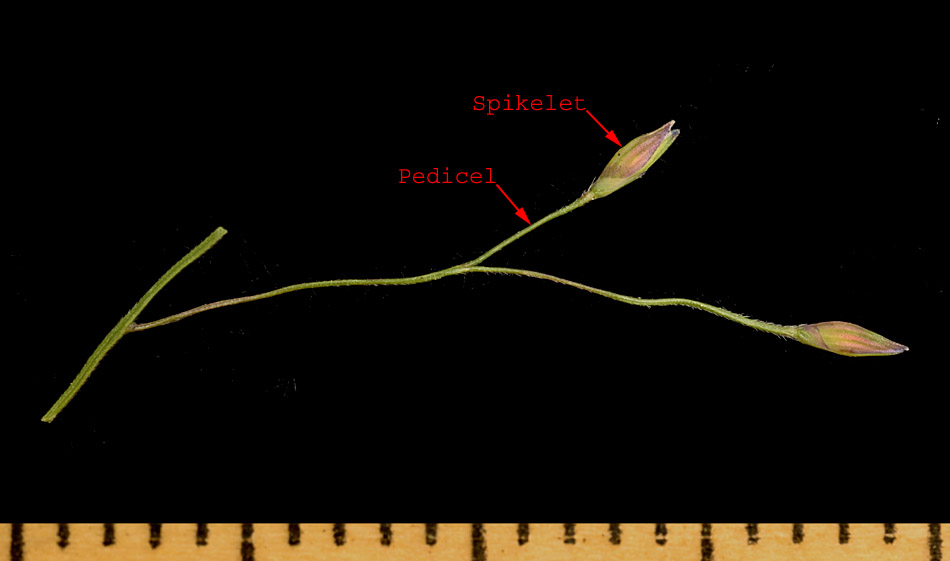 |
Paniceae: Answers to key questions
leading to this tribe.
 | Mature inflorescence, if breaking into units, then the units not as
below; NOT [Mature inflorescence breaking into spikelet units consisting
of a sessile fertile spikelet, a hairy pedicel with or without a sterile
spikelet at tip, and a hairy rachis joint, all arising at the same point
(a node) in specialized panicle branches called rames] |
 | Spikelets usually
dorsally compressed, appearing 1-flowered but containing 1 fertile
floret and 1 sterile floret, the latter attached to the base of fertile
floret opposite the upper glume, resembling the upper glume, and
together with the upper glume enveloping the fertile floret; lower
glumes minute (sometimes absent) to 3/4 as long as upper glumes and
typically wrapping most of the way around the pedicel at base; fertile
floret seed-like with chartaceous-indurate lemma and palea enclosing
flower and fruit; disarticulation below the glumes with rare exceptions; NOT
[Spikelets not as above; sterile florets if present, either located
distal to the fertile floret(s) on the rachilla or paired and attached
at the base of a single fertile floret, not paired with the upper glume
as above; lemma and palea variously textured, enclosing the flower or
not; disarticulation usually above the glumes]
|
|
 | Panicum: Answers to key questions
leading to this genus (in tribe Paniceae).
 | Spikelets lacking bristles but rachis and pedicels may have scattered,
long, papillose-based hairs; panicle not spike-like; NOT [Spikelets with
bristles attached in groups at base; panicle dense and spike-like] |
 | Lemma of sterile florets unawned; ligules present; panicle branches
not as below; NOT [Lemma of sterile florets often awned; ligules absent;
panicle branches lateral, densely-flowered and spike-like] |
 | Panicle branches not as below; ligules membranous and ciliate, or
consisting entirely of hairs; lower glume >= 1/5 length of the
spikelet, always present; NOT [Panicle branches attached near tip of
culm, spike-like, flattened and wing-margined with spikelets borne in
groups of 2-3 (5) in 2 rows along the axis on the abaxial side of
branch; ligule membranous, not ciliate; lower glume a minute triangle or
a rounded membranous flap < 1/5 length of the spikelet, or absent] |
 | Upper glume and lemma of sterile floret glabrous; basal leaves similar
to culm leaves, not forming a basal rosette; NOT [Upper glume and lemma
of sterile floret pubescent; basal leaves usually different from the
culm leaves and forming a basal rosette]
|
 | Capillare: Answers to key questions
leading to this species (in genus Panicum).
 | Plants
annual, lacking rhizomes; culms usually +/- strongly branching from
lower nodes; culm nodes pilose or puberulent; leaf sheaths densely to
sparsely pilose; NOT [Plants perennial, rhizomatous with scaly, creeping
rhizomes, often forming a knotty crown; culms unbranched at lower nodes
and rarely branched above; culm nodes glabrous; leaf sheaths glabrous
except for the throat, collar and distal margins]
|
 | Spikelets
< 4 mm long; panicles erect, not nodding at maturity, open and very
diffuse, often over 1/2 the plant length, detaching as a whole to tumble
for seed dispersal; NOT [Spikelets >= 4 mm long; panicles often
arching or nodding at maturity, usually compact, less than 1/2 as long
as wide, much less than 1/2 the plant's total length, not detaching as a
whole unit to become tumbleweeds]
|
|
|

